Research on Fine Estimation of People Trapped after Earthquake on Single Building Level Based on Multi-Source Data
Abstract
1. Introduction
2. Methods
2.1. Pre-Earthquake Phase
2.1.1. Population Distribution
- Building area S
- 2.
- Identification of the building function i
2.1.2. Indoor Population Rate
2.2. Post-Earthquake Phase
3. Study Area and Data
3.1. Study Area Profile
3.2. Data Descriptions
4. Experimental Results
4.1. Building Extraction Results
4.2. Building Function Identification Results
4.3. Building Floors Number Results
4.4. The Rural–Urban Population Results
4.5. Test Results of Damaged Buildings
4.6. Estimation and Analysis of People Trapped
5. Discussion
5.1. Data Accessibility
5.2. Effectiveness of the Method
5.3. Time Efficiency of the Method
6. Conclusions
Author Contributions
Funding
Institutional Review Board Statement
Informed Consent Statement
Data Availability Statement
Conflicts of Interest
References
- Zhou, L.; Wu, X.; Xu, Z.; Fujita, H. Emergency decision making for natural disasters: An overview. Int. J. Disaster Risk Reduct. 2018, 27, 567–576. [Google Scholar] [CrossRef]
- UNDRR. Annual Average Number of Deaths by Disaster Type. Available online: https://www.undrr.org/ (accessed on 15 February 2023).
- Kahandawa, K.A.R.V.D.; Domingo, N.D.; Park, K.S.; Uma, S.R. Earthquake damage estimation systems: Literature review. Procedia Eng. 2018, 212, 622–628. [Google Scholar] [CrossRef]
- Karimzadeh, S.; Miyajima, M.; Hassanzadeh, R.; Amiraslanzadeh, R.; Kamel, B. A GIS-based seismic hazard, building vulnerability and human loss assessment for the earthquake scenario in Tabriz. Soil. Dyn. Earthq. Eng. 2014, 66, 263–280. [Google Scholar] [CrossRef]
- Fawcett, W.; Oliveira, C.S. Casualty Treatment after Earthquake Disasters: Development of a Regional Simulation Model. Disasters 2010, 24, 271–287. [Google Scholar] [CrossRef]
- Yan, D.; Gaozhong, N.; Guiwu, S.U. Construction of an index system for evaluating earthquake emergency response ability of counties. J. Catastrophology 2010, 25, 125–129. [Google Scholar]
- Hu, W.H.; Song, L.J.; Miao, C.G.; Hou, J.S.; Yuan, Z.X. Research on Methods for Classification of Earthquake Stricken Areas and Sequencing of Disaster Degrees—Taking M8.0 Wenchuan Earthquake as an Example. J. Catastrophology 2010, 25, 30–35. [Google Scholar]
- Coburn, A.W.; Pomonis, A.; Sakai, S.; Spence, S.R. Assessing human casu-alties caused by building collapse in earthquakes. In Summa-Ries of the International Conference on the Impact of Natural Disasters; University of California: Los Angeles, CA, USA, 1991. [Google Scholar]
- Jun, H.; Shijun, C.; Ruiqing, K. The Out-Sift Rapid Assessment System of Earthquake Disaster and its Application. Inland. Earthq. 1998, 3, 234–241. [Google Scholar]
- Freire, S.; Aubrecht, C. Integrating population dynamics into mapping human exposure to seismic hazard. Nat. Hazards Earth Syst. Sci. 2012, 12, 3533–3543. [Google Scholar] [CrossRef]
- Feng, T.; Hong, Z.; Wu, H.; Fu, Q.; Wang, C.; Jiang, C.; Tong, X. Estimation of earthquake casualties using high-resolution remote sensing: A case study of Dujiangyan city in the May 2008 Wenchuan earthquake. Nat. Hazards 2010, 69, 1577–1595. [Google Scholar] [CrossRef]
- So, E.; Spence, R. Estimating shaking-induced casualties and building damage for global earthquake events: A proposed modelling approach. Bull. Earthq. Eng. 2013, 11, 347–363. [Google Scholar] [CrossRef]
- Xu, J.; Wei, F.; Zhang, L.; Fang, H.; Li, H. Prelim inary study on evaluating the number of casualties and trapped victims by a earthquake—A case study of Zhangzhou City, Fujian Province. J. Seismol. Res. 2008, 31, 382–387. [Google Scholar]
- Xiao, D.; Huang, D.; Chen, W. Prediction model for buried personnel probabilty in earthquake. J. Southwest. Jiaotong Univ. 2009, 44, 574–579. [Google Scholar]
- Wu, C.; Yin, H.T.; Wu, C.; Yin, H.T.; Sun, Q.W.; Zhang, H.; Li, X.; Dong, X.N. Study on the feasibility of the search and rescue information system based on Arcgis. Plateau Earthq. Res. 2011, 23, 54–59. [Google Scholar]
- Ranjbar, H.R.; Dehghani, H.; Ardalan, A.R.A.; Saradjian, M.R.A. GIS-based approach for earthquake loss estimation based on the immediate extraction of damaged buildings. Geomat. Nat. Hazards Risk 2017, 8, 772–791. [Google Scholar] [CrossRef]
- Huang, X.; Zhou, Z.L.; Wang, S.L. The prediction model of earthquake casuailty based on robust wavelet v-SVM. Nat. Hazards 2015, 77, 717–732. [Google Scholar]
- Mingru, Y. Study on The Assessment Method of Buried Personnel Distribution in Earthquake. Master’s Thesis, Institute of Engineering Mechanics, Harbin, China, 2014. [Google Scholar]
- Yu, S.Z.; Zhang, L.X.; Yang, M.R. Assessment of buried people distribution after earthquake. Earthq. Eng. Eng. Dyn. 2015, 35, 138–143. [Google Scholar]
- Zhou, Z.; Chen, W.; He, S.; Sun, Y.; Li, W. Application and Evaluation on a Evaluating Method for Distribution of Earthquake Buried Personnel Based on Population Kilometer Grid: Taking Minxian-Zhangxian M6.6 Earthquake as an Example. J. Seismol. Res. 2019, 42, 288–294+306. [Google Scholar]
- Bai, X.F.; Dai, Y.Q.; Ye, L.Y.; Li, C. Assessment Models of Trapped-victim in Earthquake & Emergency Rescue Area Based on High-precision Building and Population Data. J. Disaster Prev. Reduct. 2018, 34, 1–12. [Google Scholar]
- Wu, B.; Li, Z.Q.; Qi, W.H.; Yang, F.; Li, X.L.; Liu, Y.H.; Fu, B. Trapped Population Distribution in Earthquake and Rescue Policy Based on Township Residential Area Scale: A Case Study of Urumqi Area. North. China Earthq. Sci. 2017, 35, 13–19. [Google Scholar]
- Wei, B.; Nie, G.; Su, G.; Sun, L.; Bai, X.; Qi, W. Risk assessment of people trapped in earthquake based on km grid: A case study of the 2014 Ludian earthquake, China. Geomat. Nat. Hazards Risk 2017, 8, 1289–1305. [Google Scholar] [CrossRef]
- Gutiérrez, E.; Taucer, F.; De Groeve, T.; Al-Khudhairy, D.H.A.; Zaldivar, J.M. Analysis of worldwide earthquake mortality using multivariate demographic and seismic data. Am. J. Epidemiol. 2005, 161, 1151–1158. [Google Scholar] [CrossRef]
- Abeling, S.; Horspool, N.; Johnston, D.; Dizhur, D.; Wilson, N.; Clement, C.; Ingham, J. Patterns of Earthquake-Related Mortality at a Whole-Country Level: New Zealand, 1840–2017. Earthq. Spectra 2019, 36, 138–163. [Google Scholar] [CrossRef]
- Alexander, D.; Magni, M. Mortality in the L’Aquila (Central Italy) Earthquake of 6 April 2009. PLoS Curr. 2013, 5, e50585b8e6efd1. [Google Scholar] [CrossRef]
- Tian, L.L. Analysis of Influencing Factors of Casualties in Earthquake Disaster and the Formula for Estimating Casualties. Graduate Thesis, Capital University of Economics and Business, Beijing, China, 2012. [Google Scholar]
- Chen, F. Research on Earthquake Casualty Assessment Method and Program Implementation. Graduate Thesis, Xi’an University of Architecture & Technology, Xi’an, China, 2016. [Google Scholar]
- Qin, X.; Zhang, Z.; Huang, C.; Dehghan, M.; Zaiane, O.R.; Jagersand, M. U2-Net: Going deeper with nested U-structure for salient object detection. Pattern Recognit. 2020, 106, 107404. [Google Scholar] [CrossRef]
- Liu, K.; Yin, L.; Lu, F.; Mou, N. Visualizing and exploring POI configurations of urban regions on POI-type semantic space. Cities 2020, 99, 102610. [Google Scholar] [CrossRef]
- Yue, Y.; Zhuang, Y.; Yeh, A.G.-O.; Xie, J.-Y.; Ma, C.-L.; Li, Q.-Q. Measurements of POI-based mixed use and their relationships with neighbourhood vibrancy. Int. J. Geogr. Inf. Sci. 2017, 31, 658–675. [Google Scholar] [CrossRef]
- Cai, L.; Xu, J.; Liu, J.; Ma, T.; Pei, T.; Zhou, C. Sensing multiple semantics of urban space from crowdsourcing positioning data. Cities 2019, 93, 31–42. [Google Scholar] [CrossRef]
- Zhang, T.; Sun, L.; Yao, L.; Rong, J. Impact analysis of land use on traffic congestion using real-time traffic and POI. J. Adv. Transp. 2017, 2017, 7164790. [Google Scholar] [CrossRef]
- Andrade, R.; Ana, A.; Carlos, B. POI mining for land use classification: A case study. ISPRS Int. J. Geo-Inf. 2020, 9, 493. [Google Scholar] [CrossRef]
- Gao, S.; Krzysztof, J.; Helen, C. Extracting urban functional regions from points of interest and human activities on location-based social networks. Trans. GIS 2017, 21, 446–467. [Google Scholar] [CrossRef]
- Hoffmann, E.J.; Wang, Y.; Werner, M.; Kang, J.; Zhu, X.X. Model Fusion for Building Type Classification from Aerial and Street View Images. Remote Sens. 2019, 11, 1259. [Google Scholar] [CrossRef]
- Cotrufo, S.; Sandu, C.; Tonolo, F.G.; Boccardo, P. Building damage assessment scale tailored to remote sensing vertical imagery. Eur. J. Remote Sens. 2018, 51, 991–1005. [Google Scholar] [CrossRef]
- Grünthal, G. European Macroseismic Scale 1998: EMS-98; GFZ: Potsdam, Germany, 1998. [Google Scholar]
- Girshick, R. Fast r-cnn. In Proceedings of the International Conference on Computer Vision, Santiago, Chile, 13 December 2015. [Google Scholar]
- Xu, J.; Zhao, X.H.; Zhou, Q.; Xiao, B.F.; Mao, L.; Xiao, S.L.; Zhou, Y. Casualty study of the Luding, SiChuan M6.8 earthquake. J. Seismol. Res. 2023, 1–12. [Google Scholar] [CrossRef]
- Yin, Z.Q. Prediction Method of Earthquake Disaster and Loss; Earthquake Publishing House: Beijing, China, 1995. [Google Scholar]
- Krichen, M. Anomalies Detection Through Smartphone Sensors: A Review. IEEE Sens. J. 2021, 21, 7207–7217. [Google Scholar] [CrossRef]
- Liu, G.; Onnela, J.-P. Online Anomaly Detection for Smartphone-Based Multivariate Behavioral Time Series Data. Sensors 2022, 22, 2110. [Google Scholar] [CrossRef]
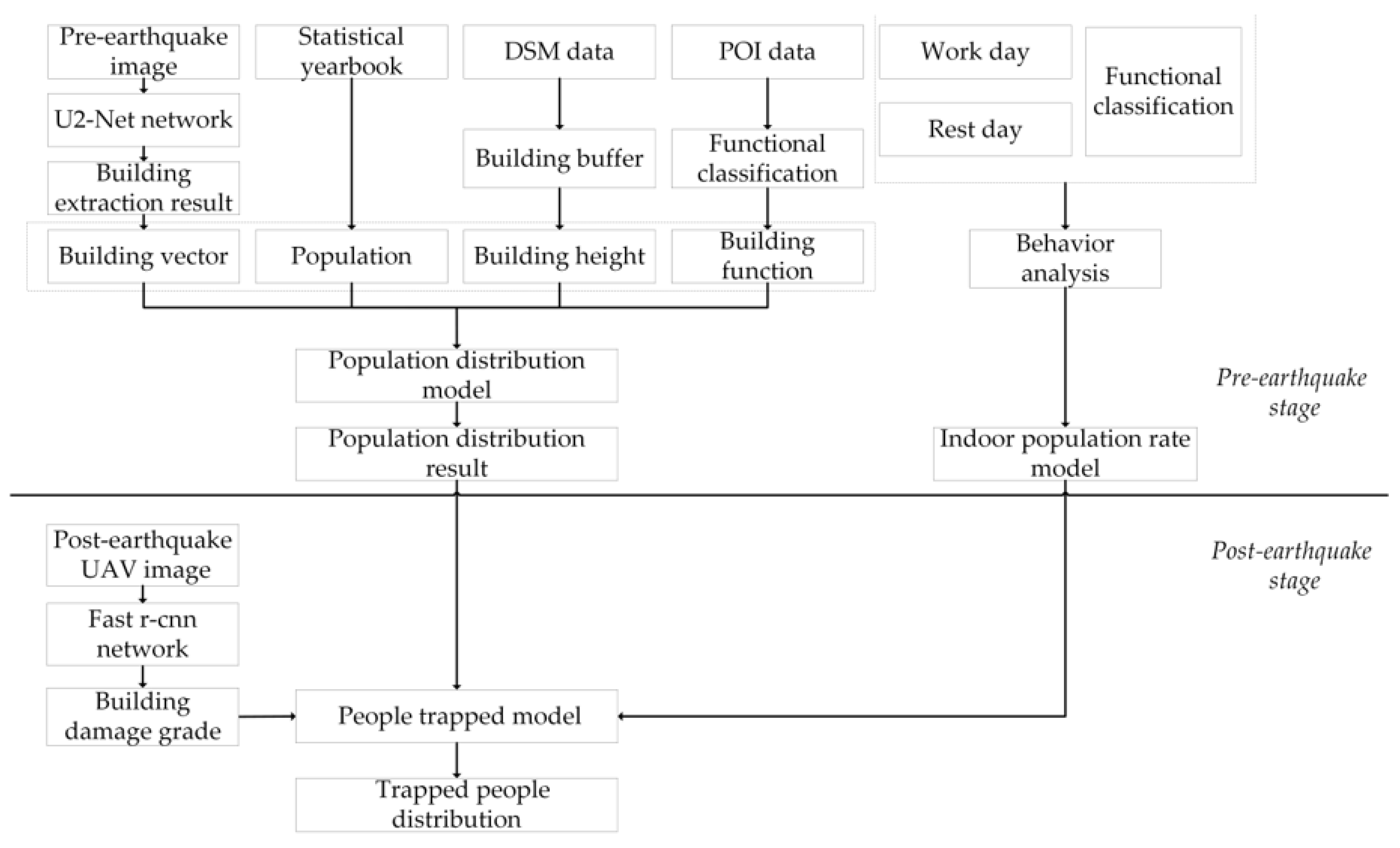
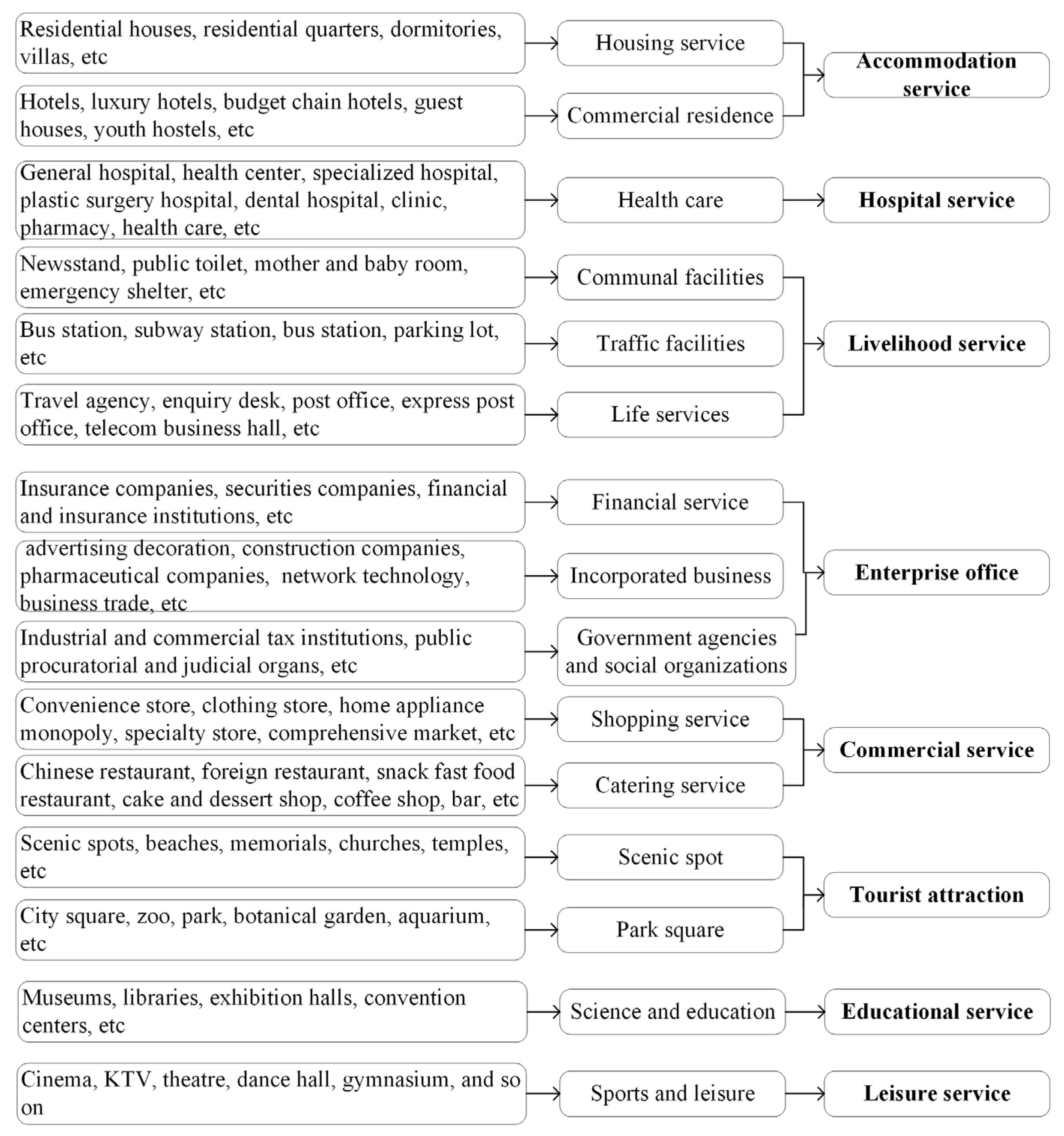
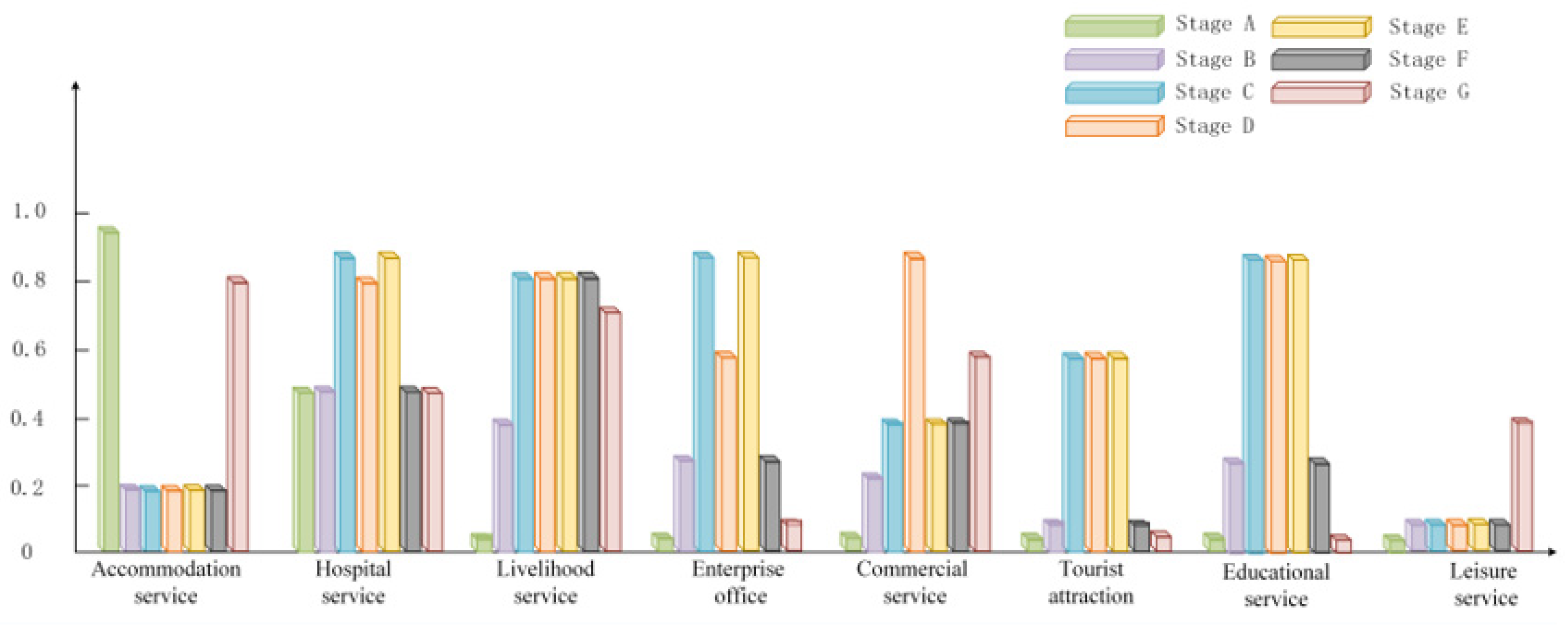
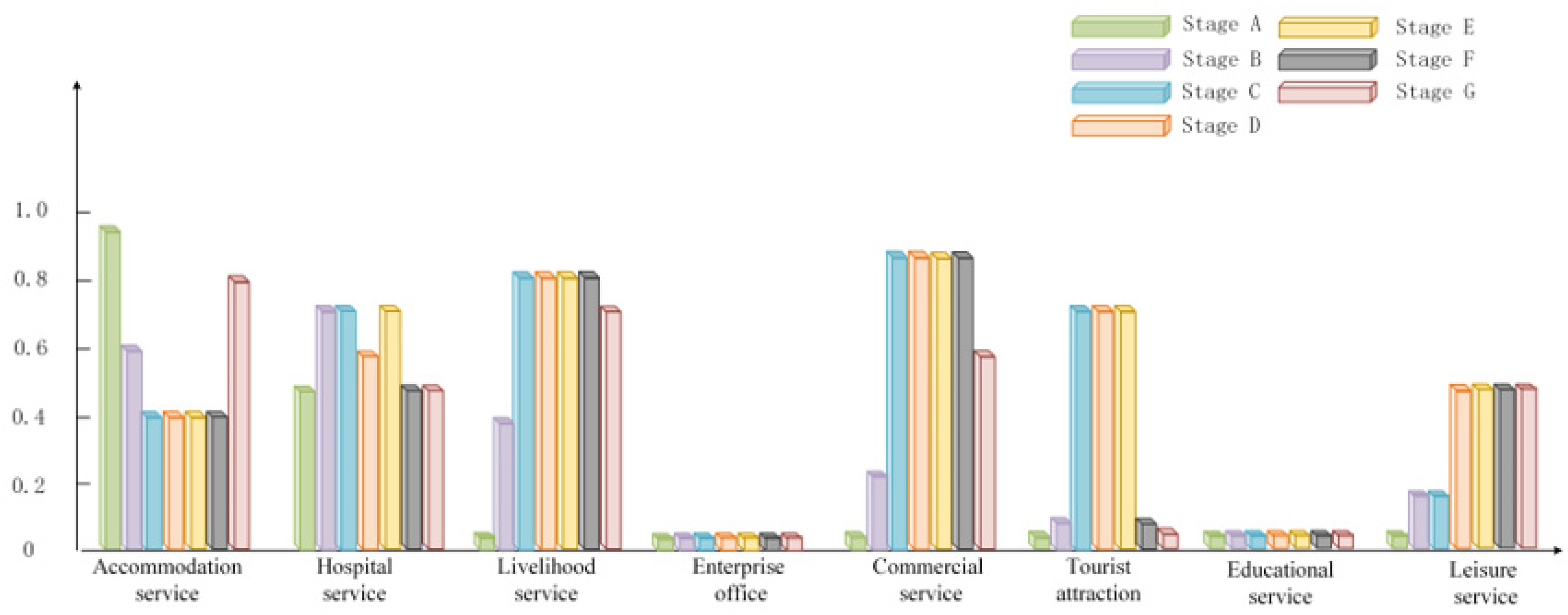
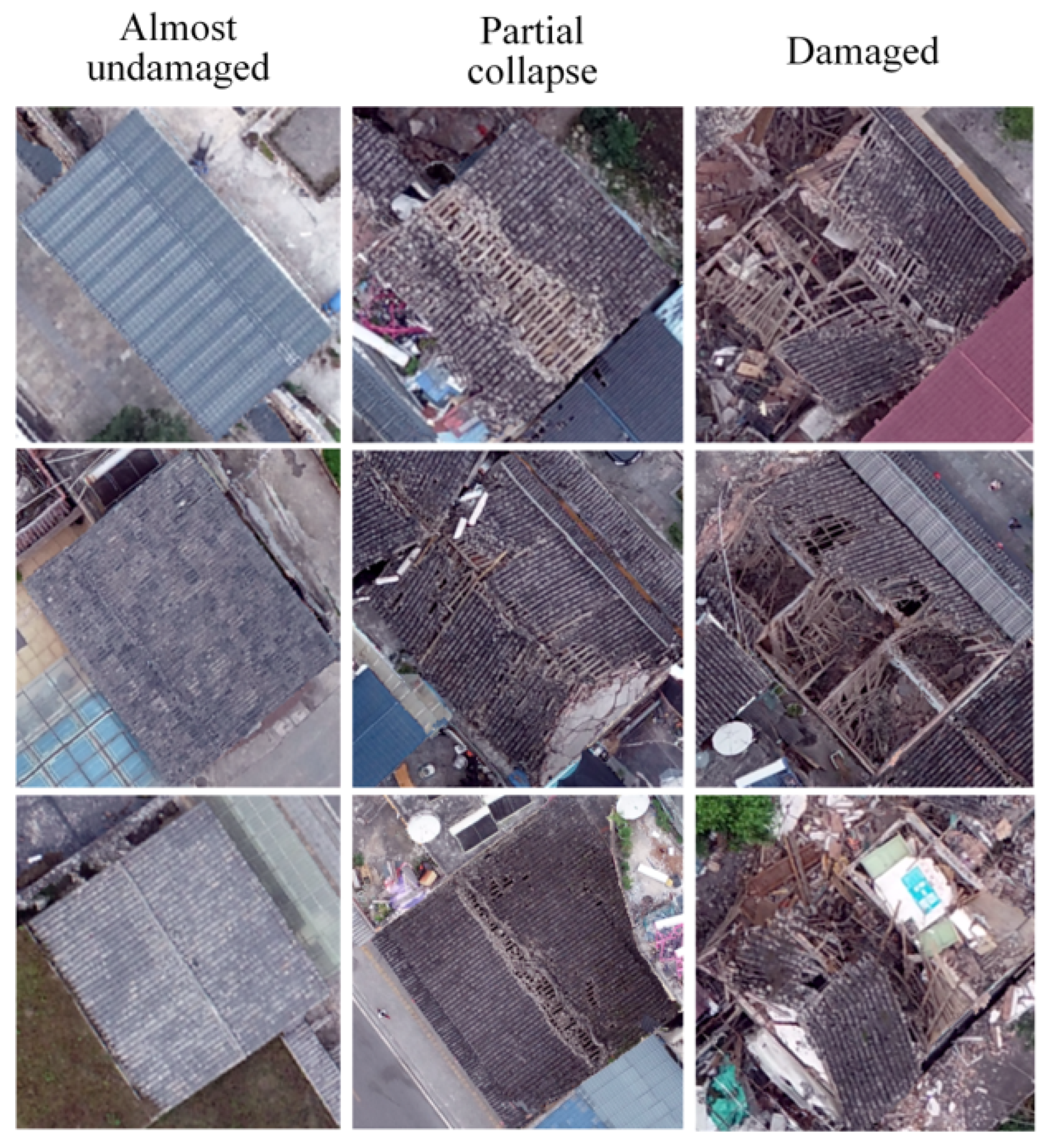
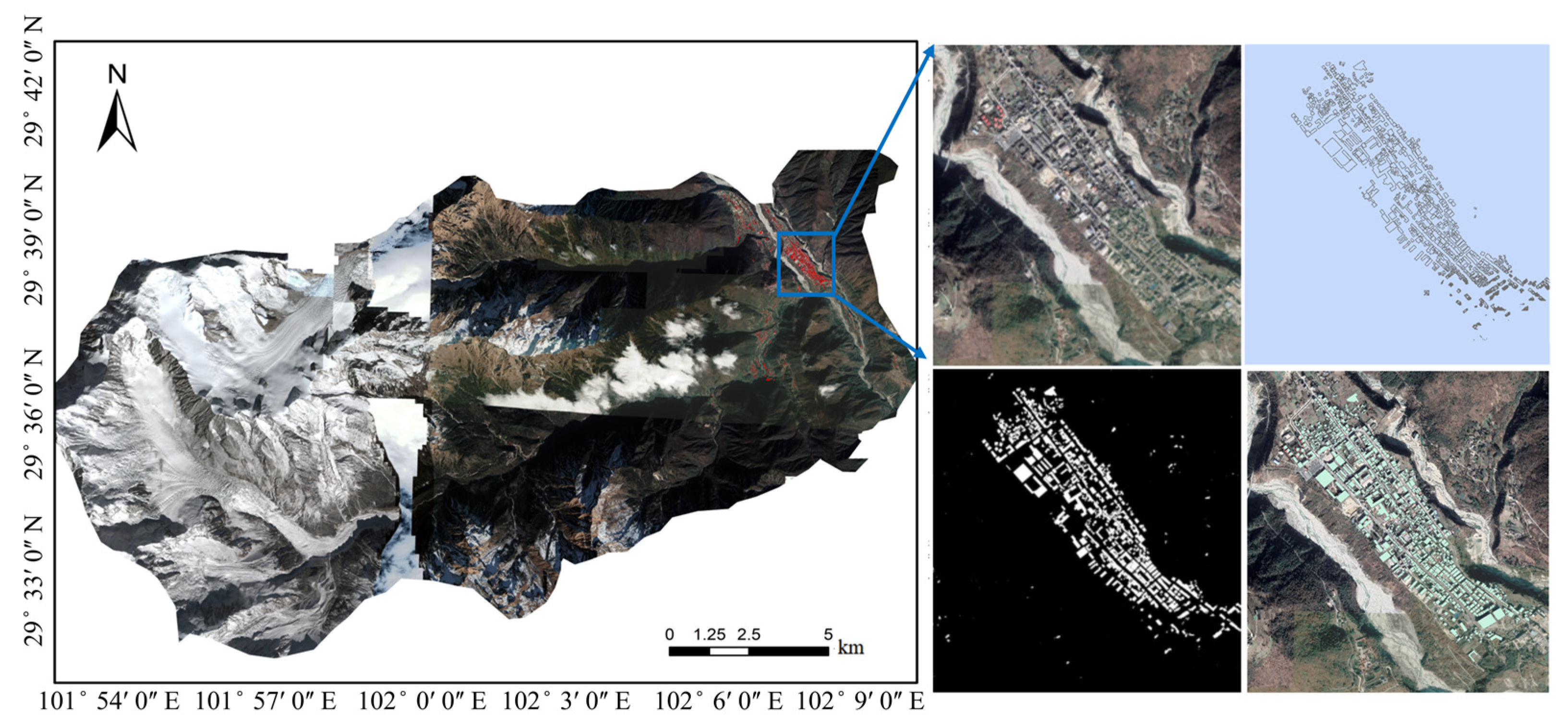

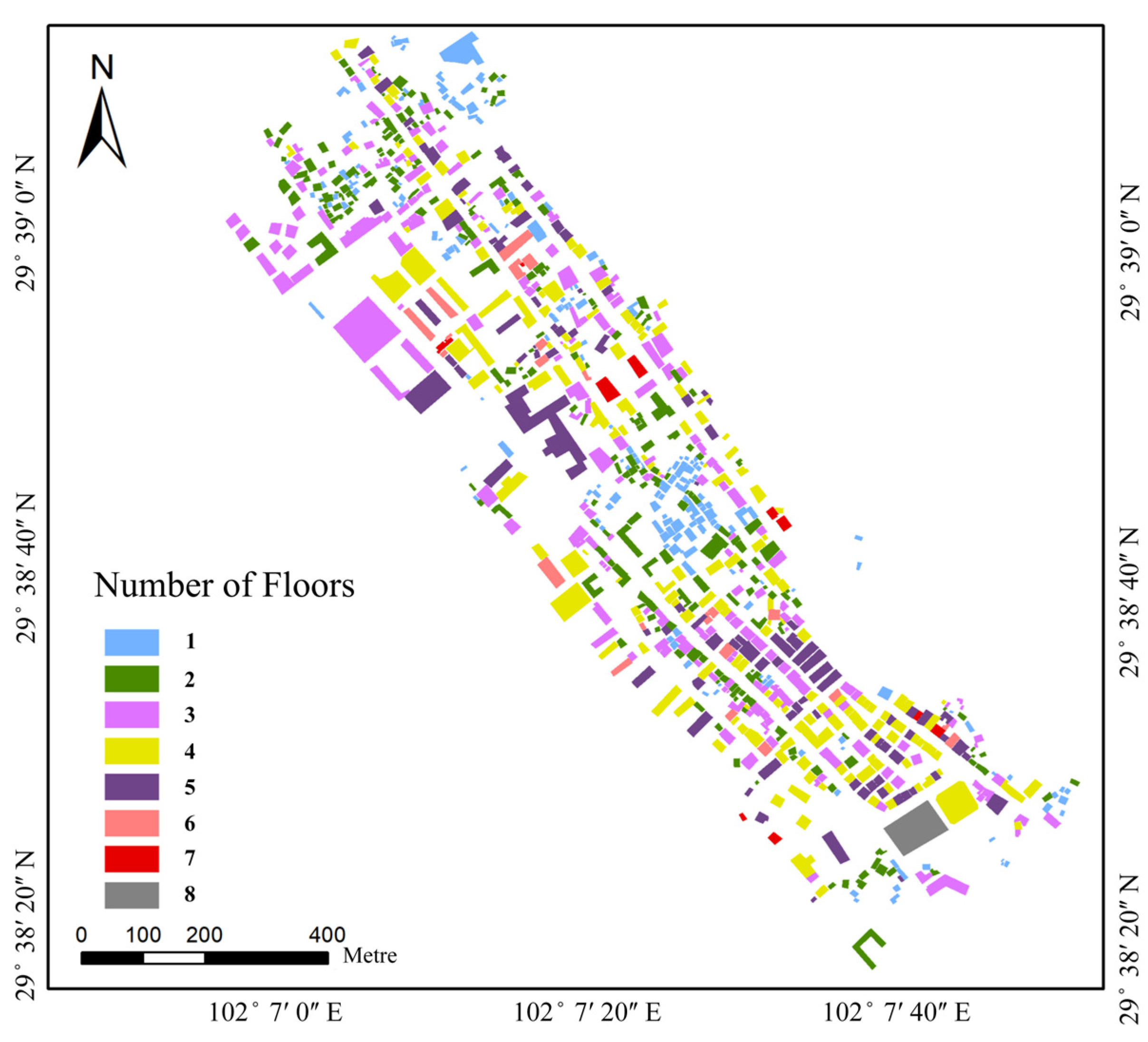
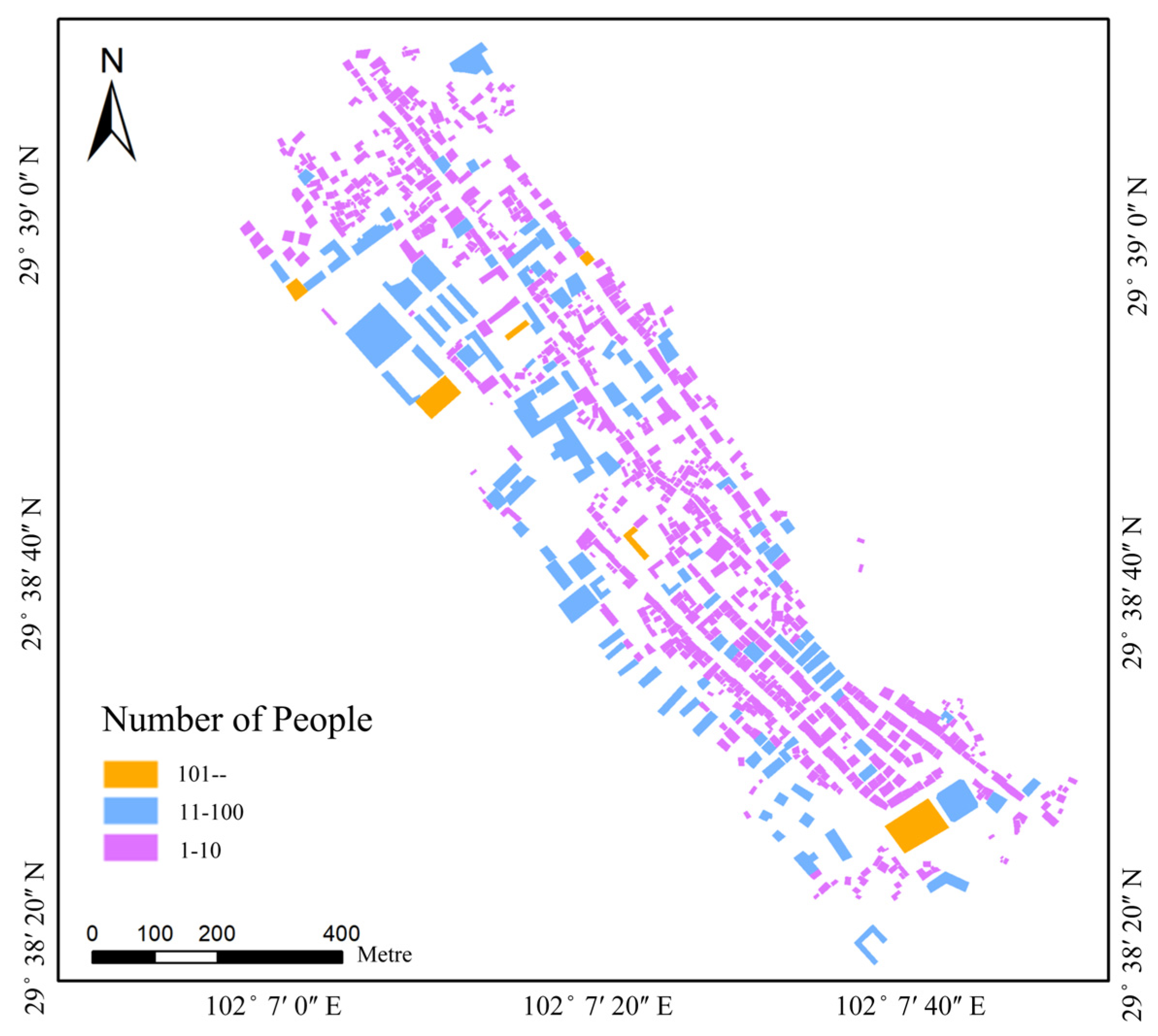
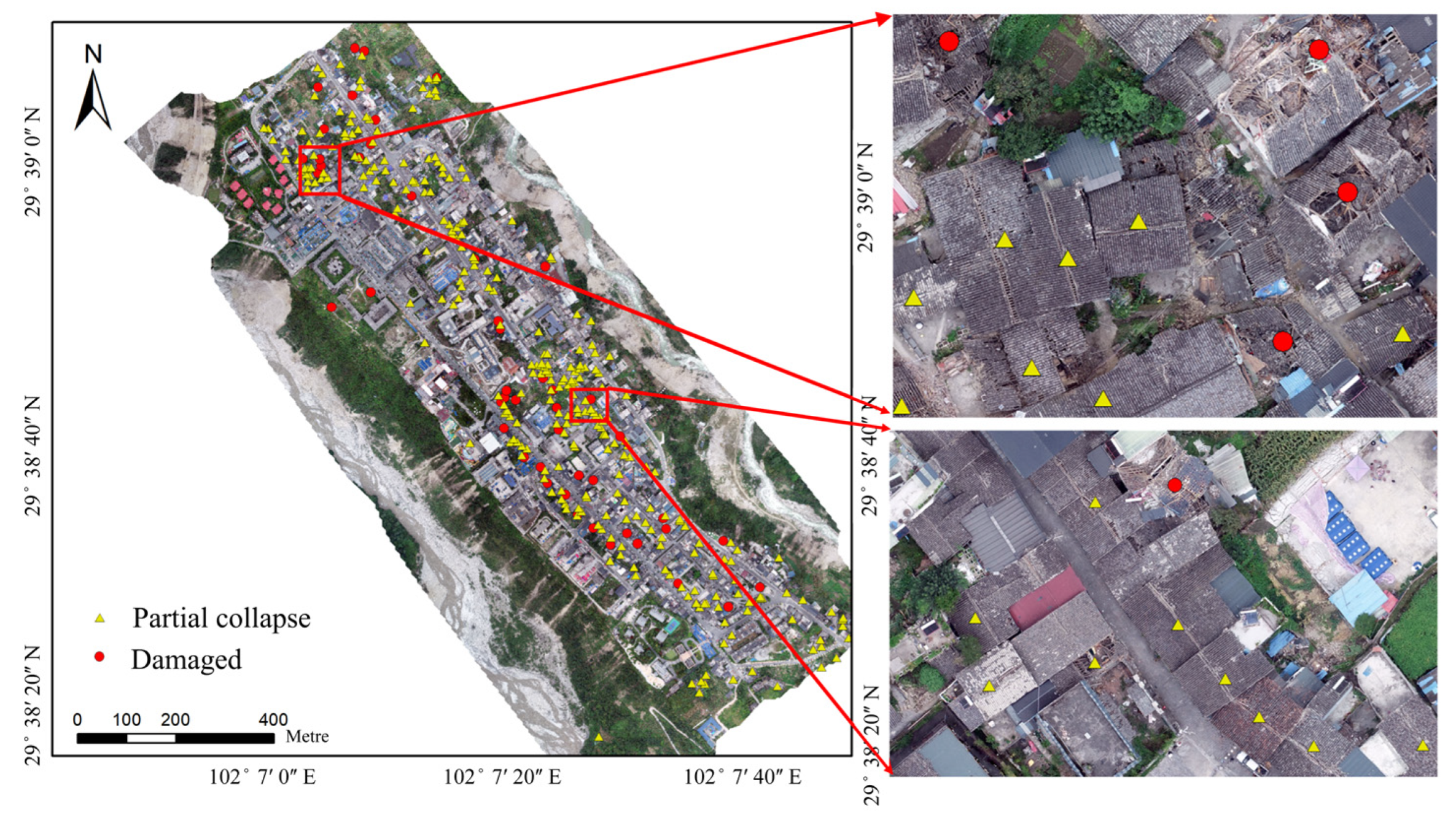
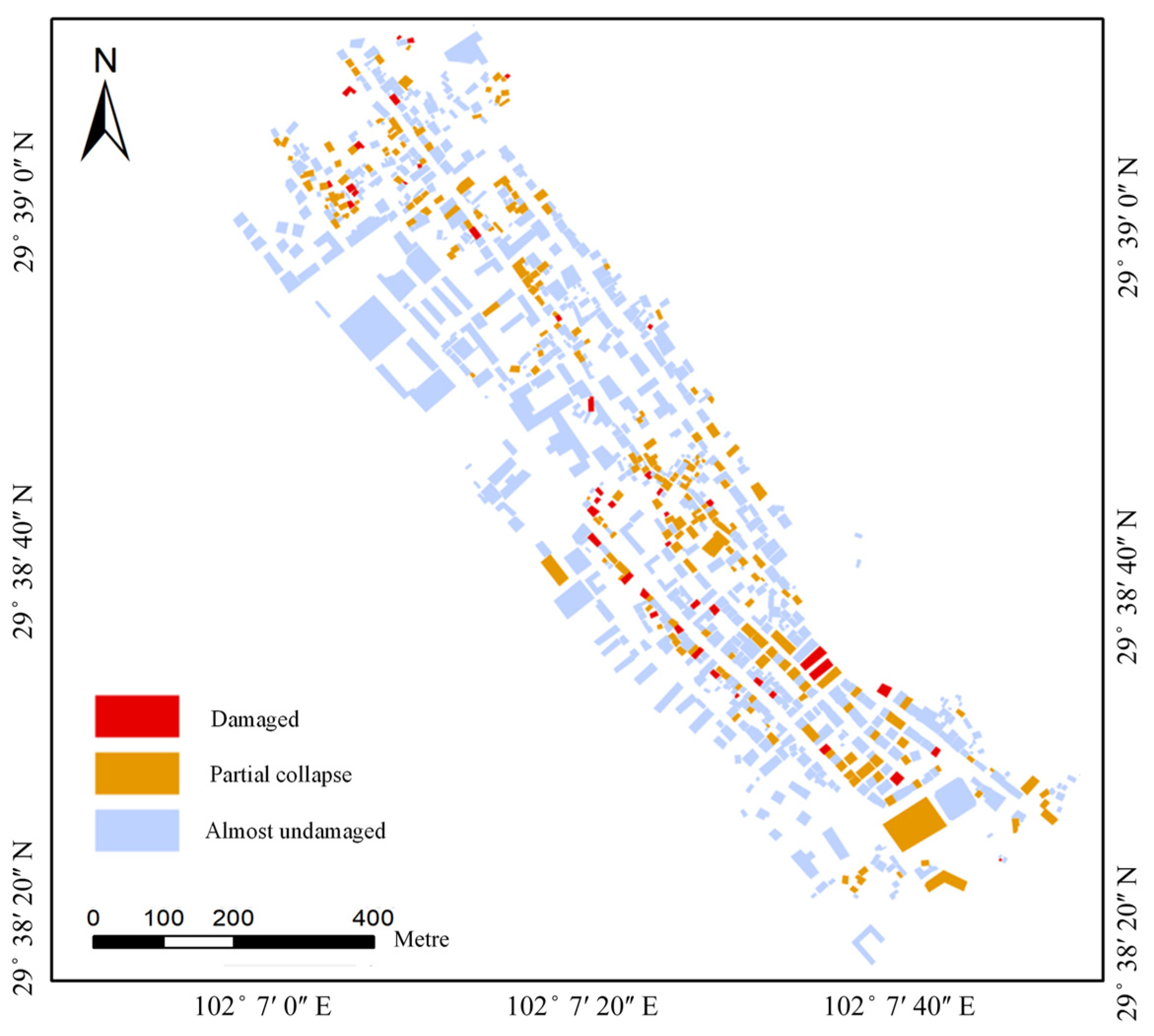
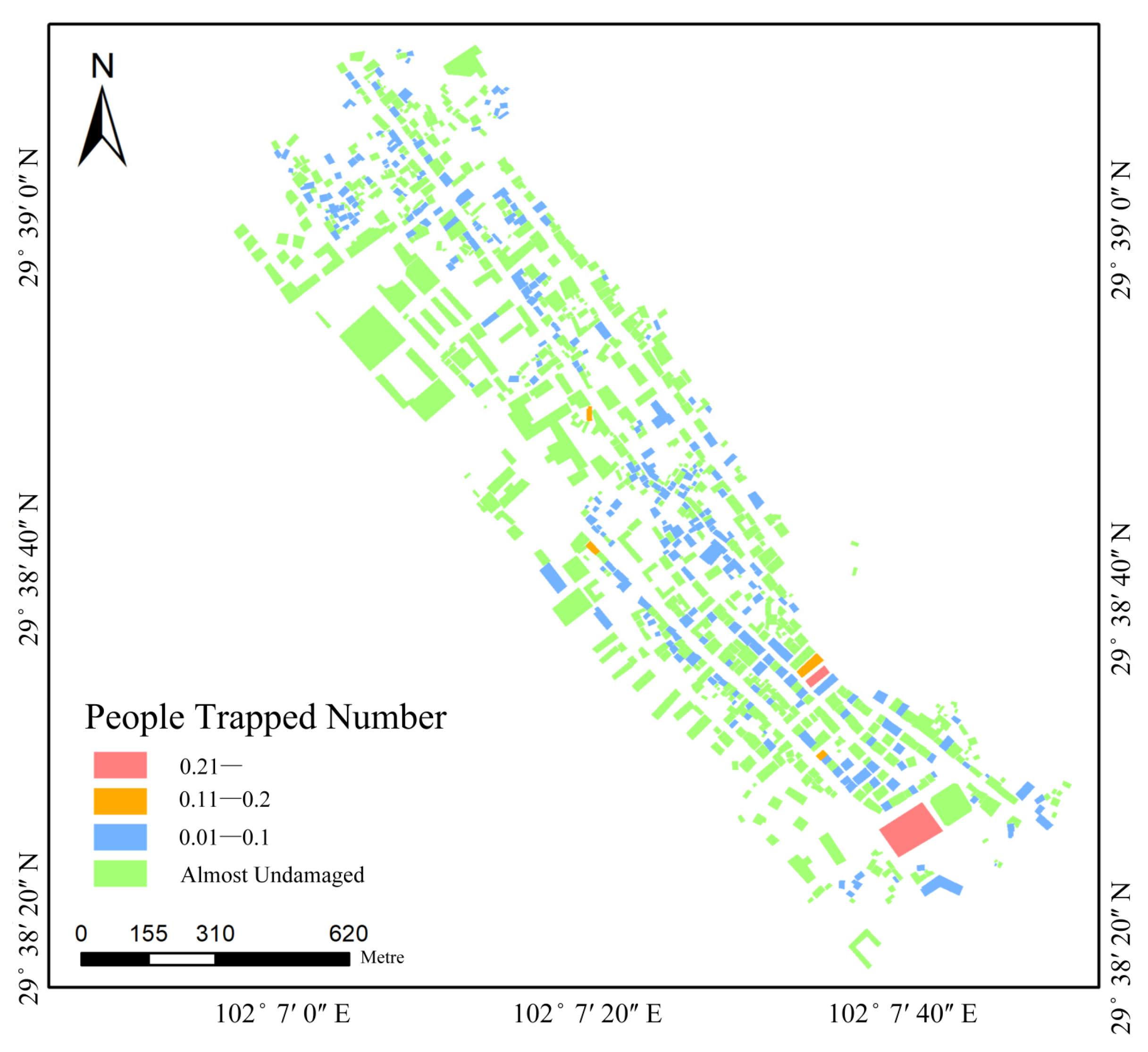

| Estimation Modeling | Methods | References |
|---|---|---|
| Seismic-based statistical model | Adding the earthquake-related parameters fitting function to the post-earthquake casualty data | [8,9,10] |
| Adding the material structure and collapse rate of buildings with the post-earthquake casualty data | [11,12,13,15] | |
| Based on the prediction model of building collapse rate and chamber rate | [14] | |
| Based on multi-source data | [16,17] | |
| Statistical model based on kilometer grid | Statistical model was optimized by superimposing multi-source data with kilometer grid as unit | [18,19,20,21,22,23] |
| Age | 8:00–17:30 | 17:30–22:00 | 22:00–8:00 |
|---|---|---|---|
| 0–14 | Educational services | Accommodation service Commercial service Leisure service | accommodation service |
| 14–60 | Hospital service Livelihood service Enterprise office | Accommodation service Hospital service Livelihood service Commercial service Leisure service Enterprise office Educational services | Accommodation service Leisure service Enterprise office Educational services Tourist attraction |
| 60+ | Leisure service Accommodation service Tourist attraction | Livelihood service Accommodation service | Accommodation service |
| Random population | Tourist attraction | Accommodation service Commercial service Leisure service | Accommodation service Commercial service Leisure service |
| Age | 8:00–17:30 | 17:30–22:00 | 22:00–8:00 |
|---|---|---|---|
| 0–14 | Educational services Leisure service Commercial service | Accommodation service Commercial service Leisure service | Accommodation service |
| 14–60 | Accommodation service Hospital service Livelihood service Commercial service Leisure service Enterprise office Educational services | Accommodation service Hospital service Livelihood service Commercial service Leisure service Enterprise office Educational services | Accommodation service Leisure service Enterprise office Educational services |
| 60+ | Leisure service Accommodation service Tourist attraction | Livelihood service Accommodation service | Accommodation service |
| Random population | Tourist attraction | Accommodation service Commercial service Leisure service | Accommodation service Commercial service Leisure service |
| EMS98 | Ours | ||
|---|---|---|---|
| Grade Name | Description | Grade Name | Description |
| Negligible to slight damage | No structural damage; slight non-structural damage | Almost undamaged | The structure of the building is complete, and the main structure has not collapsed or partial collapse |
| Moderate damage | Slight structural damage; moderate non-structural damage | ||
| Substantial to heavy damage | Moderate structural damage; heavy non-structural damage | Partial collapse | Partial collapse of the building, or partial damage to the roof, or damage to the parapet; 10–50% deformation |
| Very heavy damage | Heavy structural damage; very heavy non-structural damage | ||
| Destruction | Very heavy structural damage | Damaged | The whole building collapsed completely, or the roof collapsed completely, or more than 50% of the main structure collapsed with overall distortion, deformation, or tilt |
| Data Type | Acquisition Time | Source | Spectral Band | Spatial Resolution |
|---|---|---|---|---|
| Pre-earthquake image | April 2021 | Google Earth | RGB | 0.6 m |
| Post-earthquake image | September 2022 | UAV | RGB | 0.1 m |
| DSM data | May 2021 | National Earthquake Response Support Service | - | 0.1 m |
| POI data | April 2022 | AMap | - | - |
| Population statistics | December 2021 | Statistical Yearbook | - | - |
| Building Function | Number | Total Area (m2) |
|---|---|---|
| Accommodation service | 745 | 500,406.91 |
| Hospital service | 5 | 7988.28 |
| Leisure service | 10 | 8468.25 |
| Livelihood service | 24 | 41,733.30 |
| Enterprise office | 12 | 13,515.43 |
| Commercial service | 157 | 229,199.30 |
| Tourist attraction | 3 | 4704.00 |
| Educational services | 5 | 6924.99 |
| Total | 961 | 812,940.46 |
| Buildings Damage Grade | Damaged | Partial Collapse |
|---|---|---|
| TP | 43 | 240 |
| FN | 6 | 15 |
| FP | 8 | 12 |
| Precision | 84.31% | 95.23% |
| Recall | 87.76% | 94.12% |
| F1-Score | 86.50% | 94.67% |
Disclaimer/Publisher’s Note: The statements, opinions and data contained in all publications are solely those of the individual author(s) and contributor(s) and not of MDPI and/or the editor(s). MDPI and/or the editor(s) disclaim responsibility for any injury to people or property resulting from any ideas, methods, instructions or products referred to in the content. |
© 2023 by the authors. Licensee MDPI, Basel, Switzerland. This article is an open access article distributed under the terms and conditions of the Creative Commons Attribution (CC BY) license (https://creativecommons.org/licenses/by/4.0/).
Share and Cite
Xie, S.; Ming, D.; Yan, J.; Yang, H.; Liu, R.; Zhao, Z. Research on Fine Estimation of People Trapped after Earthquake on Single Building Level Based on Multi-Source Data. Appl. Sci. 2023, 13, 5430. https://doi.org/10.3390/app13095430
Xie S, Ming D, Yan J, Yang H, Liu R, Zhao Z. Research on Fine Estimation of People Trapped after Earthquake on Single Building Level Based on Multi-Source Data. Applied Sciences. 2023; 13(9):5430. https://doi.org/10.3390/app13095430
Chicago/Turabian StyleXie, Shizhe, Dongping Ming, Jin Yan, Huaining Yang, Ran Liu, and Zhi Zhao. 2023. "Research on Fine Estimation of People Trapped after Earthquake on Single Building Level Based on Multi-Source Data" Applied Sciences 13, no. 9: 5430. https://doi.org/10.3390/app13095430
APA StyleXie, S., Ming, D., Yan, J., Yang, H., Liu, R., & Zhao, Z. (2023). Research on Fine Estimation of People Trapped after Earthquake on Single Building Level Based on Multi-Source Data. Applied Sciences, 13(9), 5430. https://doi.org/10.3390/app13095430







